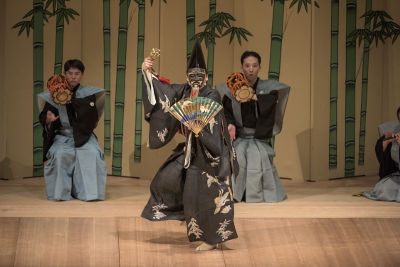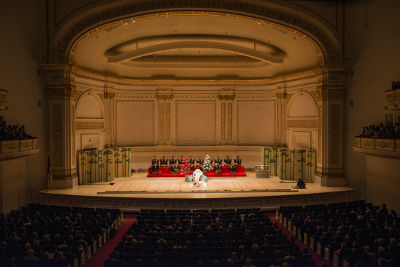
Mindy
Aloff
| Sanbanso,TsuchigumoShunkyo, Kagamijishi
Ichikawa Ebizo IX's Grand Japan Theater:
In June of 1879, just a quarter century after Commodore Perry had“opened” the country to uncontrolled trade with the West, General (andformer U.S. President) Ulysses S. Grant, with Mrs. Grant, entered Japan.They were two years into a world tour, which encompassed the Middle andFar East. During their two-month Japanese stay, one Lord Iwakura Tomomi, a highly placed minister and patron of Noh theater, invited theGrants—along with members of Japan's Imperial family—to dinner and, asafter-dinner entertainment, presented several performances of Noh andKyogen plays and dances: The Grant party is generally considered to be the first known group of Americans to have glimpsed examples of either theatrical form. According to Japanese accounts, the General was deeply moved by the program, which consisted of some ten plays and dances, and he advised Lord Iwakura to maintain the ancient, inherited repertory—whose glory days had been contemporary with the careers of Chaucer and Leonardo da Vinci—with great care, as the nuanced performance traditions could easily erode. Lord Iwakawa, encouraged by this vote of confidence for the object of his own passion from such a prestigious Westerner, initiated tremendous support for the Noh theater, and this is why General Grant is counted by some Noh historians as “among the benefactors of the restoration of Noh in the Meiji era.” (www.the-noh.com)
Among the plays to which the Grants were treated by Lord Iwakura and his Noh actors and dancers was “Tsuchigumo” (The Earth Spider), an anonymous play, of comparatively recent vintage, which is thought to be based on a chapter of the 13th- or early-14th-century epic about a war between two clans for control of Japan. “Tsuchigumo” is known especially for its spectacular moments when the Spider or Spider Spirit (sometimes transformed, sometimes candidly itself) attempts to best the Loyal Retainer by slinging spray after spray of white webbing, which erupts from the actor's wrist or hand with the specifically weighted look of chrysanthemum fireworks pouring down the night sky. (Sixty years ago, Jerome Robbins insisted on holding up production of the film of “The King and I,” for which he was the choreographer and, to some extent, the director, so that these theatrical webs, with their particular weights at the end, could be shipped from Japan for his ballet “The Small House of Uncle Thomas.”)
|
| museums | NYTW mail | recordings | coupons | publications | classified |



